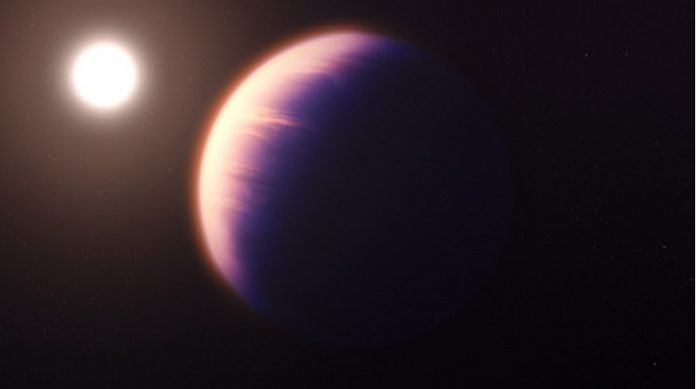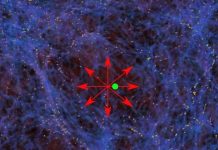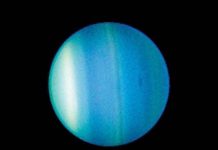
Due to its role in regulating the climate, carbon dioxide is a central component of the Earth’s atmosphere.
Being able to clearly detect the molecule in the atmosphere of distant exoplanets is therefore an essential step in the search for life-friendly worlds.
This is exactly what an international team of researchers, with participation from the University of Bern, the University of Geneva and the National Centre of Competence in Research (NCCR) PlanetS, has achieved thanks to observations with the James Webb Space Telescope.
The first results will be published in the scientific journal Nature next week.
Starlight filtered through a bloated planet’s atmosphere
The planet WASP-39b is a hot gas-giant orbiting a Sun-like star at a distance of 700 light-years from Earth.
Unlike the gas giants in our solar system, WASP-39b orbits very close to its star – only about one-eighth the distance between the Sun and Mercury – completing one revolution in just over four Earth-days.
Due to the intense insolation it receives, the planet heats up to around 900°C.
“The heat causes the planet’s atmosphere to expand, making WASP-39b a third larger than Jupiter, the largest gas giant in our solar system”, study co-author, astronomy professor at the University of Geneva and NCCR PlanetS member Monika Lendl explains.
When a planet passes directly in front of its host star, some of the star’s light passes through the planetary atmosphere before it reaches the telescope.
“The atmosphere filters out some colors of this light more efficiently than others, depending on factors such as its composition, its thickness, and its cloud content”, Lendl says.
With the James Webb Telescope, researchers can break down light into its colours to identify characteristic “fingerprints” of different gases and determine the composition of the atmosphere.
First clear detection of carbon dioxide on an exoplanet
Using the Webb Telescope’s Near-Infrared Spectrograph (NIRSpec) instrument, the team of researchers were able to detect the fingerprint of carbon dioxide in the light that passed through the atmosphere of WASP-39b.
“From the first glance at the data, it was already clear that we were dealing with a spectacular discovery,” says Dominique Petit dit de la Roche, researcher at the University of Geneva, co-author of the study and NCCR PlanetS member.
“For the first time, carbon dioxide has been clearly detected on a planet outside the solar system”.
“Detecting such a clear signal of carbon dioxide on WASP-39b bodes well for the detection of atmospheres on smaller, terrestrial-sized planets as well as for measuring abundances of other gases like water and methane,” said Natalie Batalha of the University of California at Santa Cruz, the leader of the international research team that carried out the observations.
Understanding the composition of a planet’s atmosphere also allows insights into the origin of the planet and its evolution. “Carbon dioxide molecules are sensitive tracers of the story of planet formation,” says Elspeth Lee, co-author of the study, Ambizione fellow at the University of Bern and member of the NCCR PlanetS.
“The clear detection of carbon dioxide in WASP-39b gives us information about the inventory of carbon and oxygen molecules in the atmosphere.
This gives us an idea of the diverse chemical processes that take place in atmospheres under such extreme conditions, as well as the possible rock and gas material that the planet may have picked up during its formation phases,” says Lee.
Early Release Science
The NIRSpec observations of WASP-39b are only one part of a larger investigation with the James Webb Telescope, which includes further observations of WASP-39b as well as observations of two other planets.
The observations are part of the so-called Early Release Science programme, which was developed to make scientific data from the James Webb Telescope available to the international research community as quickly as possible, thereby ensuring the best possible scientific use of the space telescope.



